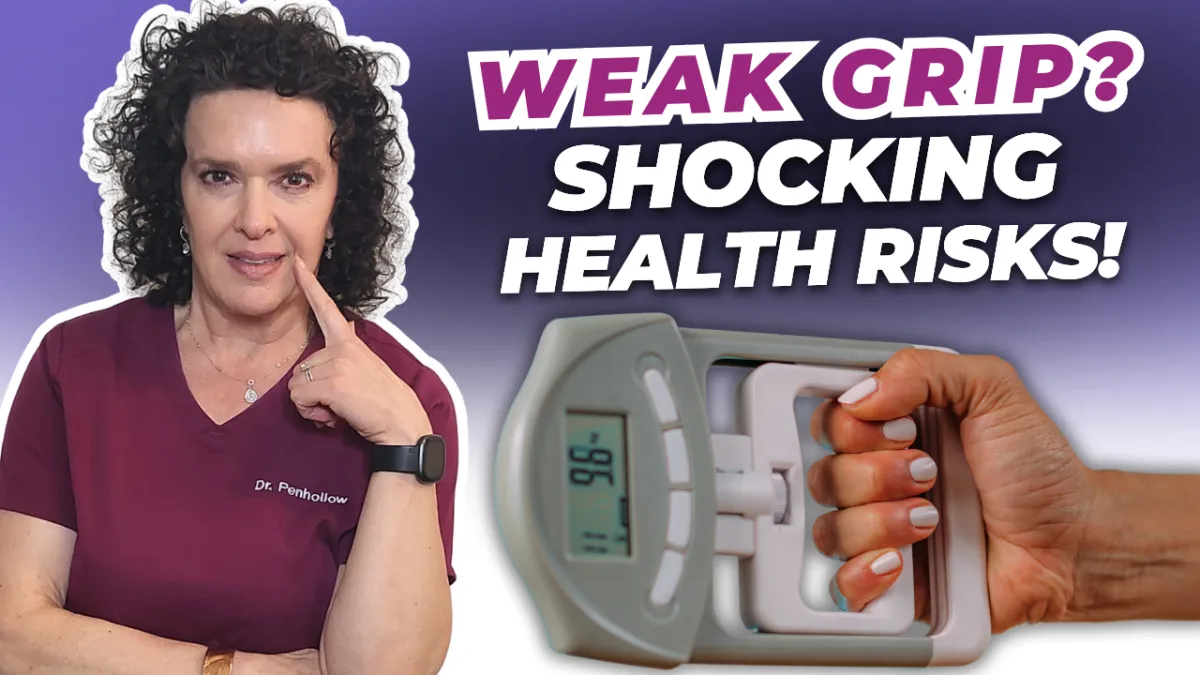
Grip Strength Reveals Heart, Bone & Brain Health! (Shocking Results!)
What if the strength of your handshake could reveal your risk of disease, injury, and longevity?
In this episode, you’ll discover how grip strength is more than just muscle. Learn why it's biomarker with surprising connections to knee health, longevity, and overall wellness.
Don’t miss out on this eye-opening insight. Dive in now before you overlook one of the most powerful predictors hiding in plain sight.
Episode Video
Most people check their health using labs, blood pressure, or the number on the scale. But there’s a simple, overlooked method that offers powerful insight, grip strength. It’s quick, non-invasive, and doesn't require needles, lab work, or even a scale. Most importantly, it's a reliable biomarker that can help predict overall wellness, disease risk, and even longevity.

Grip Strength: A Window into Your Body’s Health
Grip strength isn’t just about how strong your hands are. It’s a measurable indicator of total body health. Studies have linked strong grip strength to reduced risks of diabetes, heart disease, osteoporosis, and cognitive decline. In fact, it's now recognized as a key biomarker, an objective measurement that can reflect the body’s internal condition.
Doctors are using simple grip strength tests to assess muscle health, frailty risk, and resilience after illness. By squeezing a tool called a dynamometer, patients can get personalized results based on age and sex. The process is easy, squeeze, release, repeat, and the results offer insight into far more than just hand function.
What Does Grip Strength Have to Do with Knee Health?
It may seem unrelated, but grip strength has a direct connection to knee health and overall joint function. Strong grip is typically associated with greater muscle mass and strength throughout the body, including the muscles that stabilize and protect the knees. When grip strength is high, it often reflects better joint support, balance, and resistance to falls, factors that are crucial for knee longevity.
For patients visiting a doctor about knee pain, grip strength assessments may be included to get a full picture of musculoskeletal health. The connection lies in the fact that healthier muscle tone helps protect bones and joints, reduces pain, and improves physical performance during daily tasks.
Interpreting the Numbers
Grip strength scores fall into three categories: above average, average, and below average.
Above average grip strength suggests stronger muscle mass and a lower risk of chronic conditions such as diabetes, cardiovascular disease, and osteoporosis. It also points to better balance, reduced fall risk, and increased resilience.
Average scores indicate sufficient strength to support independence, mobility, and reduced risk of age-related health decline.
Below average grip strength can be an early sign of sarcopenia, the age-related loss of muscle mass. However, it’s also one of the easiest areas to improve with consistent strength training.
Grip Strength as a Predictor of Disease
Low grip strength has been linked to a wide range of health issues:
Type 2 diabetes and insulin resistance
Heart disease, high blood pressure
Osteoporosis and fracture risk
Cognitive decline, including dementia and Alzheimer’s
This simple test can be used to forecast risk levels and intervene early. By assessing grip strength, doctors gain a deeper understanding of a patient’s muscular, metabolic, cardiovascular, and neurological health, all without invasive testing.
Improving Grip Strength and Total Body Health
Grip strength can absolutely be improved, but the focus should go beyond hand exercises alone. Full-body resistance training, using weights, resistance bands, and compound movements, is essential. These exercises work multiple joints and muscle groups at once, contributing to overall strength and resilience.
Examples include:
Weight training with dumbbells or bands (especially exercises that lead to muscle fatigue within 8 to 10 reps)
Hanging from a bar to build grip endurance and upper-body strength
Everyday activities like carrying groceries, lifting laundry baskets, and gardening
Targeted wrist curls and hand squeezes for grip-specific improvement
While hand-focused exercises can improve grip, they only tell part of the story. Since grip strength is a biomarker for whole-body health, the most effective approach includes regular strength training that builds muscle across the entire body.
Final Thoughts
Grip strength is a low-effort test with high-impact results. It offers a simple way to evaluate wellness, forecast health risks, and monitor functional strength, all of which are crucial for preserving knee health, preventing falls, and maintaining independence as we age.
For those concerned with joint pain, muscle loss, or general aging, testing grip strength is an easy place to start. It provides valuable feedback and opens the door to proactive, strength-focused solutions that improve both quality of life and long-term outcomes.
If you're ready to take control of your knee pain, click here to discover more about these five effective knee pain home treatments. With these simple steps, you can start your journey towards pain-free knees and a more active lifestyle.
